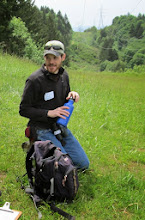
Last Sunday, we "tidepooled" at Cape Kiwanda. The tidepools here are actually sandstone rocks covered by beds of mussels, barnacles, and countless other organisms.

Life is tough in the inter-tidal zone, and for me, viewing mussel beds is similar to watching predators stalk and consume their prey on the Serengeti, but on a much smaller and slower scale.
A few feet of sand had been deposited on the beach since the last time we here, burying the lower layers of the mussel beds. The largest mussels are usually found high above the water at low tide, where they have grown old in the absence of predatory seastars that dry out if they climb too high. The newly deposited sand had lowered the large mussels' elevation, however, and a feast was on!

Several seastars were in the process of wrapping their arms around the mussels, opening the shells, and digesting the contents from the inside-out.

Sarah spotted someting strange sticking out from an opened mussel shell. As we looked close, the thing appeared segmented and worm-like. I tapped it on it's side and it withdrew its head from the shell.

It was a carnivorous mussel worm (Nereis vexillosa) that was probably cleaning out what had been left in the shell by a seastar. It had two fleshy "fangs" and a bony "lip" that can apparently deliver a painful bite. These worms are abundant in mussel beds throughout the Pacific coast, but I had not seen one before.
California Mussels are my favorite tidepool creatures because the create an ecosystem with their presence.

Their shells are attachment sites for sessile creatures such as acorn and goose-necked barnacles pictured above. Worms and other free-moving animals find protection from predators and waves in the gaps between mussel shells. Some crabs even live inside the shells of mussels without bothering their hosts. Mussels: another example of valuable oceanside real estate!






No comments:
Post a Comment